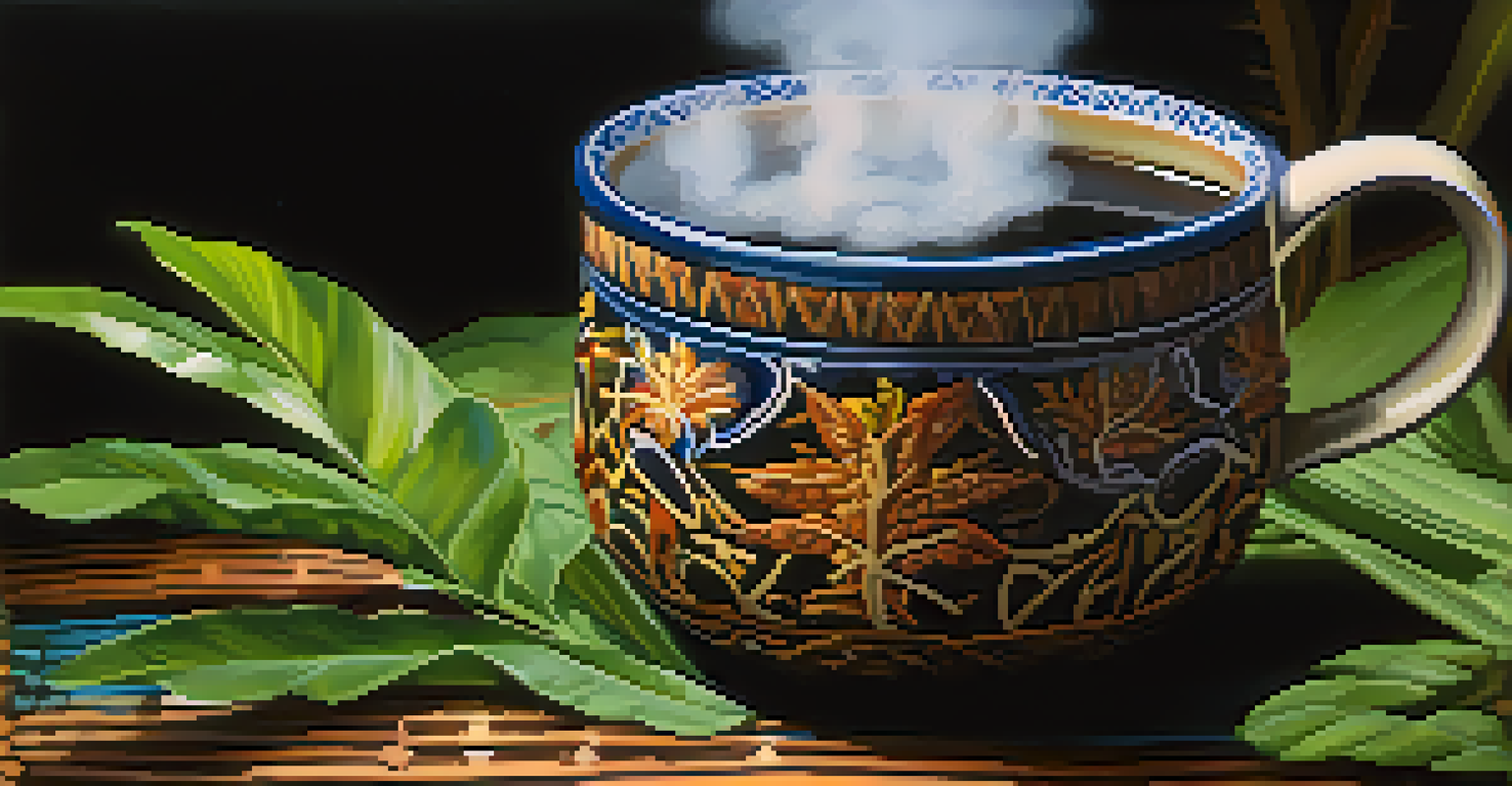Ceremony Location: Sacred Spaces and Ayahuasca Effects

Understanding the Importance of Sacred Spaces
Sacred spaces are locations imbued with spiritual significance, often used for rituals and ceremonies. These places can range from ancient temples to serene natural settings, each fostering a unique atmosphere. The energy within these spaces can enhance the overall experience of participants, creating a deeper connection to the spiritual realm.
The wound is the place where the Light enters you.
For many, the act of entering a sacred space serves as a mental cue to shift focus from the mundane to the spiritual. This transition is crucial, especially in practices like ayahuasca ceremonies where participants seek profound insights. The very environment encourages introspection and can lead to heightened awareness during the experience.
Incorporating elements like natural beauty, cultural artifacts, and community presence, these spaces hold the potential to amplify the effects of ayahuasca. When individuals gather in such locations, they not only share an experience but also contribute to a collective energy that can nurture healing and transformation.
Ayahuasca: A Brief Overview and Its Origins
Ayahuasca is a powerful plant medicine traditionally used by indigenous tribes in the Amazon for spiritual and healing purposes. The brew, made from the Banisteriopsis caapi vine and other local plants, is known for its psychoactive properties. Many participants report experiencing vivid visions and deep emotional releases during ceremonies, often leading to transformative insights.

Historically, ayahuasca was used in sacred rituals, where shamans guided participants through their journeys. This guidance was essential, as the shaman's role was to ensure a safe and supportive environment. The integration of traditional practices with modern approaches has led to a growing interest in ayahuasca beyond its native context.
Sacred Spaces Enhance Experiences
Entering a sacred space helps participants shift their focus, fostering a deeper connection to the spiritual realm.
Today, ayahuasca ceremonies are held in various settings around the world, attracting those seeking healing, self-discovery, and connection to something greater. While the allure of these experiences is strong, understanding the cultural significance and proper context remains vital for participants.
The Role of Ceremony Leaders in Ayahuasca Experiences
Ceremony leaders, often referred to as shamans or facilitators, play a crucial role in guiding participants through their ayahuasca experiences. Their knowledge and expertise help create a safe environment where individuals can explore their inner selves. The presence of a skilled leader can significantly impact the overall experience and outcomes for participants.
In the middle of difficulty lies opportunity.
These leaders often draw upon ancient traditions, using songs, chants, and rituals to enhance the ceremony's spiritual ambiance. Their ability to navigate the emotional and spiritual landscapes that arise during the experience is essential for ensuring participants feel supported. In many cases, the relationship between the leader and participants fosters trust, which is vital for deep exploration.
Additionally, ceremony leaders often provide post-ceremony integration support, helping participants make sense of their experiences. This follow-up is crucial, as the insights gained during ayahuasca journeys can be profound and sometimes overwhelming. A good leader ensures that individuals leave the ceremony with clarity and a sense of direction.
Setting Intentions: A Key Element in Ayahuasca Ceremonies
Setting intentions is a fundamental practice in ayahuasca ceremonies, as it helps participants clarify their goals for the experience. Individuals often spend time reflecting on what they hope to learn or heal, creating a personal focus for their journey. This intentionality can greatly influence the outcomes of the experience, guiding the visions and insights that arise.
When participants articulate their intentions, they open themselves up to receiving messages from the plant spirit. This process allows for a deeper connection between the individual and the medicine, leading to more meaningful revelations. It's not uncommon for participants to leave the ceremony with a renewed sense of purpose or clarity about their life path.
Ceremony Leaders Guide Journeys
Skilled ceremony leaders create a safe and supportive environment, essential for participants' exploration and integration of their experiences.
Moreover, the communal aspect of setting intentions can enhance the group dynamic during the ceremony. When everyone shares their intentions, it fosters a sense of unity and support among participants. This collective energy can amplify the potency of the experience, creating a powerful space for healing.
The Impact of Environment on Ayahuasca Experiences
The environment in which an ayahuasca ceremony takes place can profoundly influence the experience of participants. Elements such as lighting, sounds, and even the temperature can affect the emotional and spiritual landscape. For instance, a dimly lit room with soothing sounds can create a calming atmosphere, making it easier for participants to relax and open up.
Natural settings, such as forests or mountains, often provide a unique backdrop that enhances the spiritual connection during the ceremony. Many participants report feeling a deep sense of oneness with nature, which can amplify the healing effects of ayahuasca. This connection to the environment can lead to powerful insights and a greater appreciation for the world around us.
Conversely, a chaotic or uncomfortable setting can hinder the experience, making it challenging for participants to engage deeply with the medicine. Therefore, choosing the right location is essential, as it sets the stage for the transformative journey. A well-curated environment can foster safety, comfort, and openness, allowing for a more profound exploration.
Ayahuasca's Effects: Emotional, Spiritual, and Physical
Ayahuasca is known for its complex effects that can manifest emotionally, spiritually, and physically. Many individuals report experiencing intense emotional releases, often confronting past traumas or unresolved issues. This cathartic process can lead to a sense of relief and clarity, paving the way for healing and personal growth.
Spiritually, participants often describe a feeling of connection to a higher consciousness or the universe. This sense of unity can be profoundly transformative, helping individuals gain insights into their purpose and place in the world. Such experiences can foster a lasting shift in perspective, encouraging a more mindful and intentional approach to life.
Setting Intentions is Crucial
Articulating intentions before an ayahuasca ceremony enhances personal focus and fosters a sense of unity among participants.
Physically, ayahuasca can induce various sensations, ranging from nausea to a heightened sense of awareness. While some may find the physical effects challenging, many view them as part of the cleansing process. Embracing these sensations can lead to a deeper understanding of oneself and the release of stagnant energy.
Integrating Ayahuasca Experiences into Daily Life
After participating in an ayahuasca ceremony, the integration process becomes essential for maintaining the insights gained. Individuals are encouraged to reflect on their experiences, journaling their thoughts and feelings to solidify their understanding. This practice can help bridge the gap between the spiritual revelations and everyday life.
Building a support system is also crucial during this time, as sharing experiences with others can provide validation and clarity. Many participants find solace in connecting with like-minded individuals who have undergone similar journeys. This community aspect fosters a sense of belonging and encourages ongoing personal growth.

Finally, integrating lessons from the ceremony into daily routines can enhance personal development. Whether it's adopting new mindfulness practices, making lifestyle changes, or cultivating healthier relationships, the key is to remain open to transformation. Embracing these shifts can lead to a more fulfilling and joyful life.